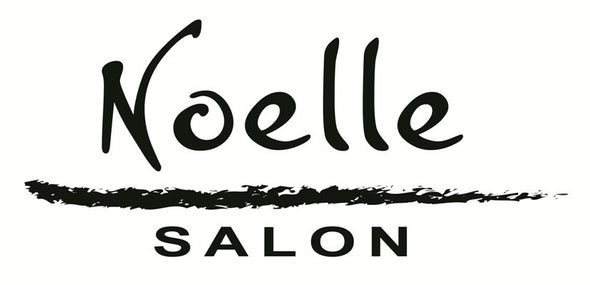What Is a Hair Topper? A Must-Read Guide for First-Time Users

What Is a Hair Topper? Here’s Everything You Need to Know
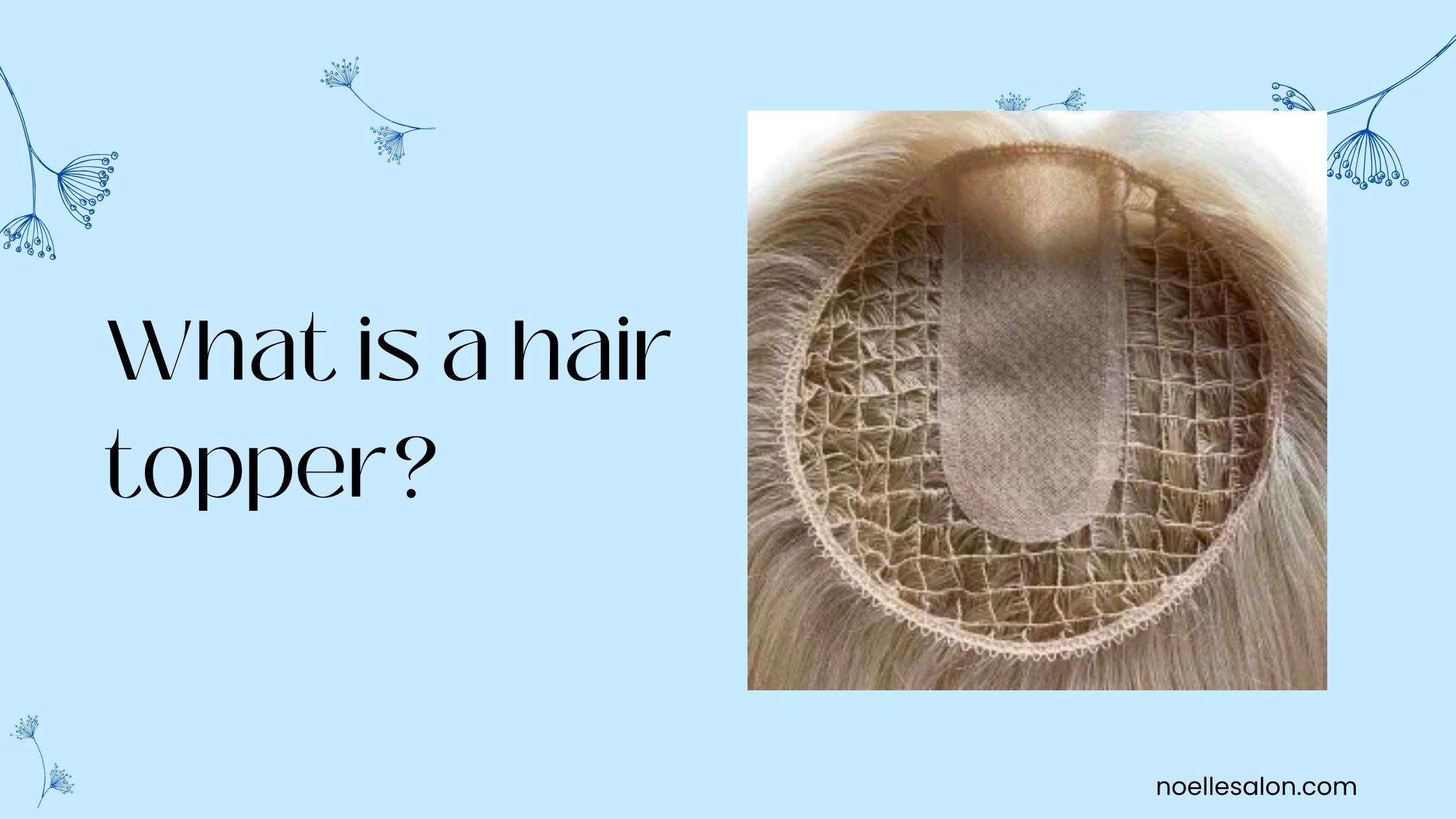
|
TL;DR
|
|---|
Ever notice a little thinning at the crown or part and wish you could just clip something on to make it disappear? You’re not alone, and that’s exactly where hair toppers come in. Whether you're dealing with hair loss, volume gaps, or simply want to have voluminous hair, hair toppers are a game-changing solution that’s far more natural and lightweight than you might expect. In this guide, we’ll break down everything you need to know, starting from the most basic question: What is a topper for hair?
What is a Hair Topper for Women?
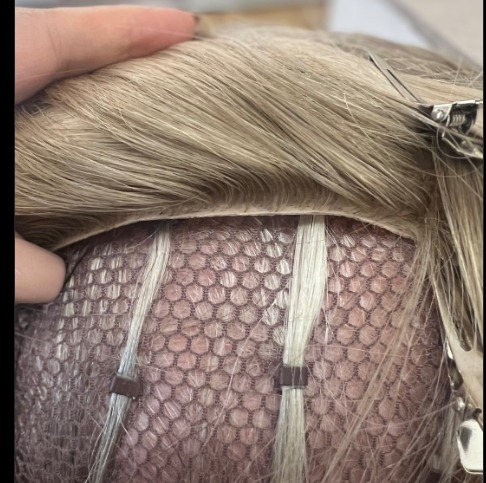 A hair topper is a hairpiece designed to conceal thinning or balding areas on the scalp, typically at the crown, part line, or top of the hair. Unlike full wigs, toppers blend with your natural hair, adding volume and coverage only where you need it, instead of the entire head. They come in a variety of styles, sizes, lengths, and base types to match different stages of hair loss and personal preferences.
A hair topper is a hairpiece designed to conceal thinning or balding areas on the scalp, typically at the crown, part line, or top of the hair. Unlike full wigs, toppers blend with your natural hair, adding volume and coverage only where you need it, instead of the entire head. They come in a variety of styles, sizes, lengths, and base types to match different stages of hair loss and personal preferences.
Hair toppers can be made from synthetic or human hair and are usually attached with discreet clips, making them easy to apply and remove. They're a versatile, confidence-boosting solution for anyone experiencing hair thinning or just looking to enhance their hairstyle. If you're wondering: Do hair toppers look natural?, then the answer is "Yes", hair toppers can look incredibly natural when properly matched to your hair color, texture, and density. With the right placement and styling, they blend seamlessly with your own hair.
How Hair Toppers Differ from Wigs and Extensions?
Hair toppers differ from extensions and wigs in both purpose and coverage. While wigs cover the entire scalp and are ideal for full hair loss, hair toppers are designed to blend with your existing hair, offering targeted coverage for thinning areas, especially at the crown or part.
Unlike extensions, which add length or volume to the sides and back of your hair, toppers focus on concealing hair loss at the top of the head. They offer a lightweight, breathable alternative that enhances natural volume without the need for a full wig or long wefts.
How Do Hair Toppers Work?
Hair toppers work by clipping onto your existing hair to cover thinning or balding spots, typically at the crown, part, or front of the scalp. They come with built-in pressure-sensitive clips that securely attach to your natural hair, allowing for easy placement and removal without damage.
The base of the topper is designed to mimic the look of the scalp, so when blended properly with your hair, it creates a seamless, natural appearance. Whether made from synthetic or human hair, toppers can be styled to match your look and boost volume exactly where you need it most.
Now that you know what is a human hair topper, let us understand who can benefit from it.
Who Can Benefit from Using a Hair Topper?
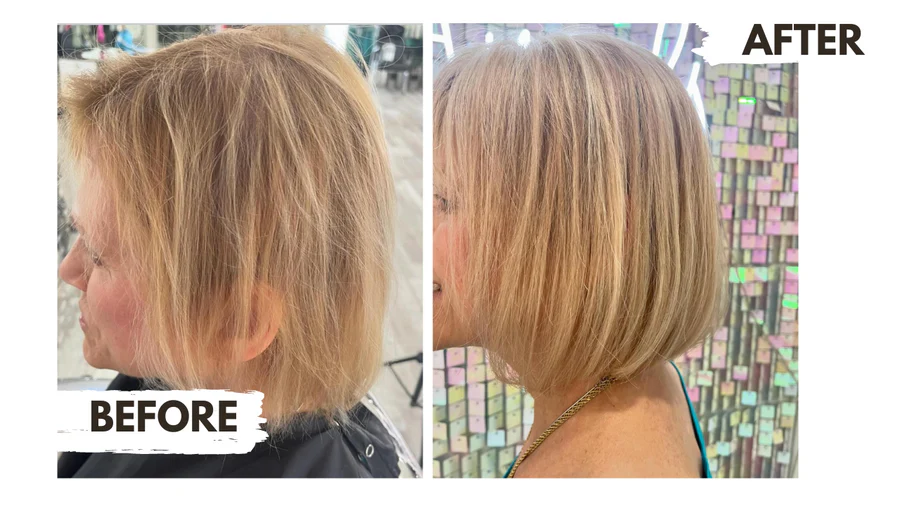 Hair toppers are an ideal solution for anyone experiencing thinning or hair loss in specific areas of the scalp, particularly at the crown, part line, or front. They’re perfect for those who still have a decent amount of natural hair but want to add volume or coverage where it matters most, to have a full head of hair. Whether your hair concerns stem from medical, hormonal, or lifestyle factors, hair toppers are a lifesaver that offer a discreet, non-surgical way to boost confidence and achieve a fuller look.
Hair toppers are an ideal solution for anyone experiencing thinning or hair loss in specific areas of the scalp, particularly at the crown, part line, or front. They’re perfect for those who still have a decent amount of natural hair but want to add volume or coverage where it matters most, to have a full head of hair. Whether your hair concerns stem from medical, hormonal, or lifestyle factors, hair toppers are a lifesaver that offer a discreet, non-surgical way to boost confidence and achieve a fuller look.
People who can benefit include:
-
Women with thinning hair at the crown or along the part line due to genetics or aging
-
Postpartum mothers dealing with temporary hair shedding
-
Individuals experiencing hormonal hair loss during menopause or perimenopause
-
People with medical conditions such as alopecia or thyroid disorders
-
Those recovering from chemotherapy and experiencing regrowth
-
Anyone with traction alopecia from tight hairstyles or extensions
-
Professionals, performers, or public figures seeking quick volume enhancement for daily styling or special events
Hair toppers are a versatile and customizable option that caters to a wide range of needs, whether you're looking for full coverage, added volume, or simply more confidence in your appearance.
What are the Different Types of Toppers Available?
Hair toppers come in various base constructions, each offering a different level of realism, comfort, and styling flexibility. The right type for you depends on your needs—whether it's a natural-looking hairline, maximum breathability, or scalp-like realism. Here are the best toppers for hair loss:
1. What Is a Mono Hair Topper?
A monofilament base hair topper features a thin, breathable mesh base where each hair is hand-tied individually. This gives the illusion of hair growing directly from the scalp, allowing for natural parting in any direction. Mono toppers are lightweight and comfortable, making them ideal for daily wear and for those with sensitive scalps.
2. What Is a Lace Front Hair Topper?
A lace front hair topper includes a sheer lace panel at the front, where individual hairs are hand-tied to mimic a natural hairline. This design allows for off-the-face styling and blends well with the skin at the forehead. Lace fronts are perfect if you want a realistic hairline and plan to style your hair away from your face.
3. What Are Silk Base Toppers?
Silk base toppers are known for offering the most natural scalp appearance. They consist of multiple layers, with knots hidden beneath a silk layer, so there’s no visible grid or lace. This gives the illusion that hair is growing directly out of your scalp. While slightly thicker and less breathable than mono or lace bases, silk base toppers are ideal if realism is your top priority.
How to Wear a Hair Topper? Step-By-Step Process
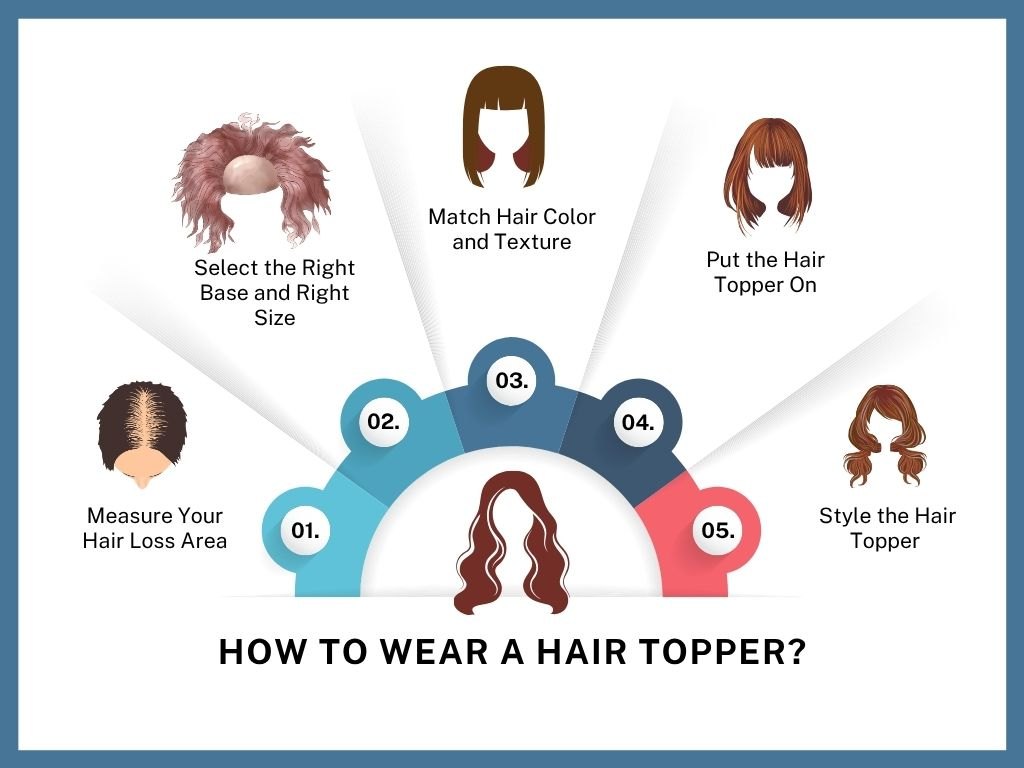 Wearing a hair topper for the first time may feel intimidating, but with the right approach, it can become a simple and empowering part of your beauty routine. From measuring your thinning area to styling the final look, every step plays a crucial role in achieving a seamless and natural blend. Here’s how to do it the right way:
Wearing a hair topper for the first time may feel intimidating, but with the right approach, it can become a simple and empowering part of your beauty routine. From measuring your thinning area to styling the final look, every step plays a crucial role in achieving a seamless and natural blend. Here’s how to do it the right way:
What You’ll Need to Get Started (Tools & Essentials)?
Before you begin, gather the following:
-
A flexible measuring tape
-
A fine-tooth comb or tail comb
-
Hair clips or sectioning clips
-
Mirror (preferably two for better visibility)
-
Your chosen hair topper
-
Optional: hair fibers or concealers for extra blending, heat tools for styling
Step 1 (Measure) - How to Measure Your Hair Loss Area?
The first step is identifying the area where your hair is thinning or sparse. Use the measuring tape to take two measurements: one from front to back, and the other from side to side across the thinning zone. This helps determine the right topper size.
To ensure the clips can grip securely, always add an extra half inch to an inch on each side of the area. This ensures your topper will attach to strong, healthy hair, which is essential for comfort and staying power.
Step 2 (Select) - How to Select the Right Base and the Right Size?
With your measurements in hand, the next step is selecting a topper that suits your needs. Choose a base size that is slightly larger than the area of hair loss to allow for proper clip placement. If your hair loss is mild, a smaller base will do; for moderate to advanced thinning, a larger base offers better coverage.
Equally important is the base type: monofilament, lace front, or silk, each offering different benefits in terms of comfort, realism, and styling flexibility. The goal is to choose the perfect hair topper that not only fits but also suits your lifestyle and hair loss pattern.
Step 3 (Match) - How to Match Hair Color and Texture?
A perfectly matched hair topper is key to achieving a natural look. The trick is to match the topper’s color to the mid-length and ends of your real hair, rather than the roots, since that’s the area it will blend with most. Pay attention to undertones (cool, warm, or neutral), as well as highlights or lowlights if your hair has dimensional color. Matching the texture is equally crucial; a straight topper won’t blend well with wavy or curly hair. If in doubt, many brands offer color-matching services or swatches to help you find the best option.
Step 4 (Install) - How to Put a Hair Topper On?
Now that you've selected and matched your topper, it's time to put on the hair topper. Begin by brushing and preparing your natural hair. Part it where you normally do, then open all the clips on the underside of the topper. Position the front edge of the topper where your hair begins to thin, either at or just behind your natural hairline.
Press the front clip down first to secure it, then work your way to the side and back clips, pressing each one down so it grips your natural hair firmly. Once all clips are secured, gently blend your natural hair with the topper for a smooth transition without any discomfort.
Step 5 (Styling) - How to Style a Hair Topper?
Styling your topper is the final step in making it truly yours. If it’s a human hair topper, you can use heat tools like curling wands or flat irons to style it just like your natural hair. For synthetic toppers, use only heat tools rated safe for synthetic fibers.
Blend the topper with your natural hair by curling or straightening them together to eliminate any visible separation. You can also use volumizing powder or a teasing comb to add lift at the crown area. A light mist of hairspray or finishing spray can help hold the style in place and complete your look.
What are Some Tips for Maintaining and Caring for Your Hair Topper?
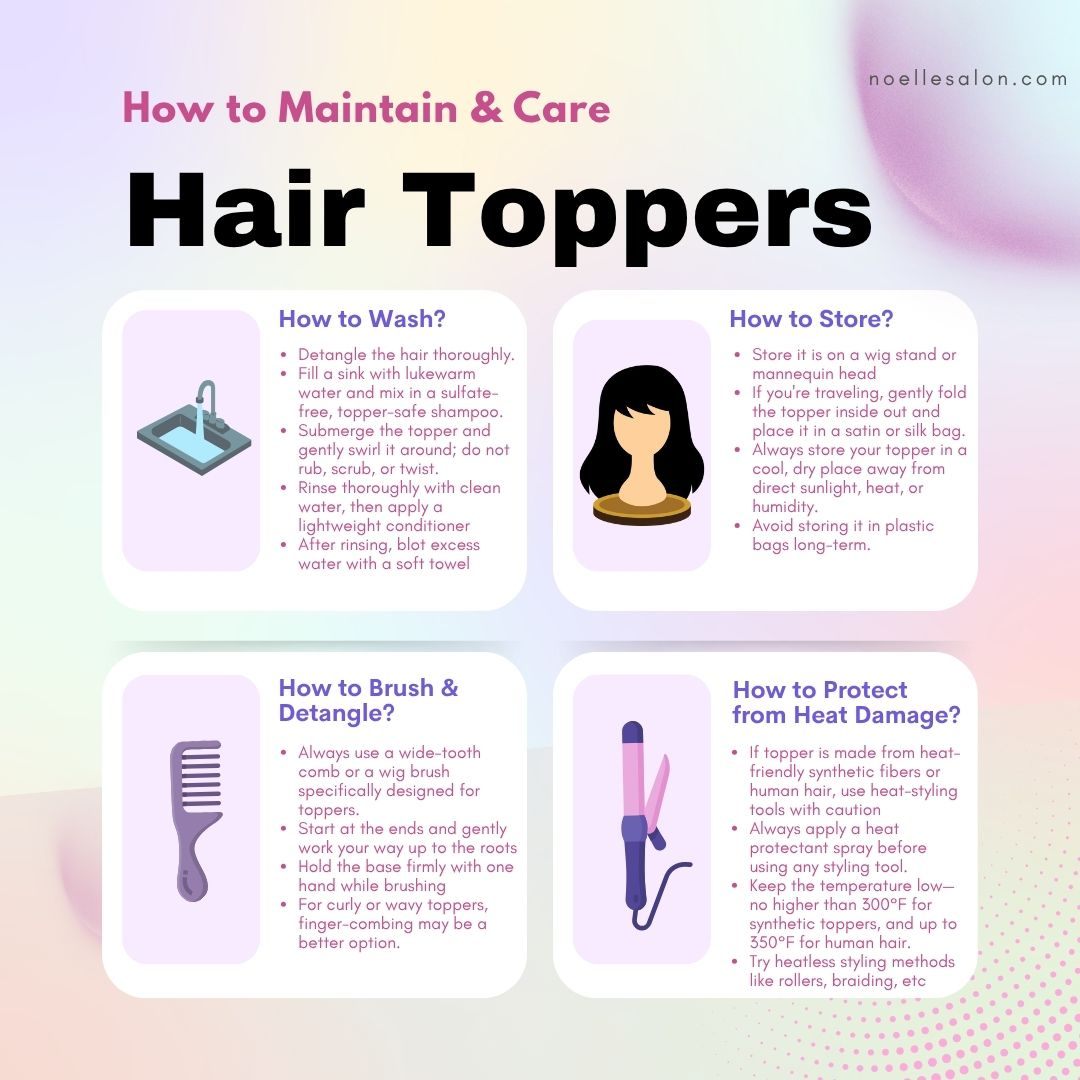
Proper care and maintenance can significantly extend the lifespan of your hair topper and keep it looking natural and fresh. Whether it's made from synthetic fibers or human hair, a little routine attention goes a long way in preserving its quality, texture, and shape. Here's how to take care of a hair topper:
How to Wash a Hair Topper?
Cleaning your hair topper doesn’t have to be complicated, but it’s important to be gentle. First, detangle the hair thoroughly. Fill a sink or basin with lukewarm water and mix in a sulfate-free, topper-safe shampoo. Submerge the topper and gently swirl it around; do not rub, scrub, or twist.
Rinse thoroughly with clean water, then apply a lightweight conditioner to the mid-lengths and ends (avoiding the base). After rinsing, blot excess water with a soft towel, never wring it out. Place the topper on a wig stand or mannequin head and let it air dry completely before styling or storing.
How to Store a Hair Topper?
When not in use, proper storage will help maintain your topper’s shape and keep it free from tangles or dust. The best way to store it is on a wig stand or mannequin head to preserve its style, ensure longevity, and prevent creases. If you're traveling or short on space, you can gently fold the topper inside out (hair inward) and place it in a satin or silk bag. Always store your topper in a cool, dry place away from direct sunlight, heat, or humidity. Avoid storing it in plastic bags long-term, as they can trap moisture and lead to damage or mold growth.
How to Brush and Detangle a Hair Topper?
Brushing your hair topper the right way prevents shedding and extends its life. Always use a wide-tooth comb or a wig brush specifically designed for toppers. Start at the ends and gently work your way up to the roots to avoid pulling or tearing. Hold the base firmly with one hand while brushing to minimize tension on the clips or base. For curly or wavy toppers, finger-combing may be a better option to maintain the curl pattern and avoid frizz.
How to Protect Your Hair Topper from Heat Damage?
If your hair topper is made from heat-friendly synthetic fibers or human hair, use heat-styling tools with caution. Always apply a heat protectant spray before using any styling tool. Keep the temperature low—no higher than 300°F (150°C) for synthetic toppers, and up to 350°F (175°C) for human hair. Frequent heat styling can reduce the lifespan of your topper, so try heatless styling methods like rollers, braiding, or curling rods whenever possible.
Where Can I Try on Hair Toppers Near Me?
At Noelle Salon, we invite you to try on hair toppers in a comfortable, private setting where your confidence comes first. We understand how personal hair loss can be, which is why we offer one-on-one consultations to help you find a topper that looks and feels completely natural. You’ll have the chance to explore different styles, base types, and colors, and we’ll be right there to guide you every step of the way, from fit to customization. When you leave our salon, we want you to feel empowered, beautiful, and like yourself again. Book an appointment today.
Frequently Asked Questions
Where can I buy a hair topper near me?
Hair toppers are available at wig boutiques, salons, and online stores that specialize in hair loss solutions. Noelle Salon offers high-quality toppers along with personalized consultations and fittings to help you find the perfect match.
How much does a hair topper cost?
Hair topper prices vary based on hair type, base construction, and brand. Synthetic toppers start around $150, while human hair options can range from $300 to $1,200 or more. Noelle Salon carries options for various budgets and offers expert guidance on choosing the right one.
How do hair toppers stay on?
Hair toppers typically attach using built-in pressure-sensitive clips that grip your natural hair securely. Some styles also offer tape or adhesive options for extra hold, especially for those with more advanced hair loss.
How to trim a hair topper?
Trimming a hair topper should be done carefully to ensure it blends naturally with your hair. It's best to have it customized by a professional stylist. Noelle Salon specializes in cutting and styling toppers for a flawless, natural look.
What are the best quality hair toppers?
The best toppers are made from 100% Remy human hair with hand-tied bases like monofilament or silk. Noelle Salon is known for offering top-tier human hair toppers that are durable, realistic, and fully customizable to suit your needs.
What is the difference between a hair piece and a hair topper?
While the terms are sometimes used interchangeably, a hair topper is a specific type of hairpiece designed to cover thinning or balding areas at the crown or part line, blending with your natural hair. A hairpiece, on the other hand, is a broader term that includes any partial hair addition, such as bangs, ponytails, or clip-ins, that may not necessarily target hair loss. Hair toppers focus on coverage and realism, especially for those experiencing thinning on top.
